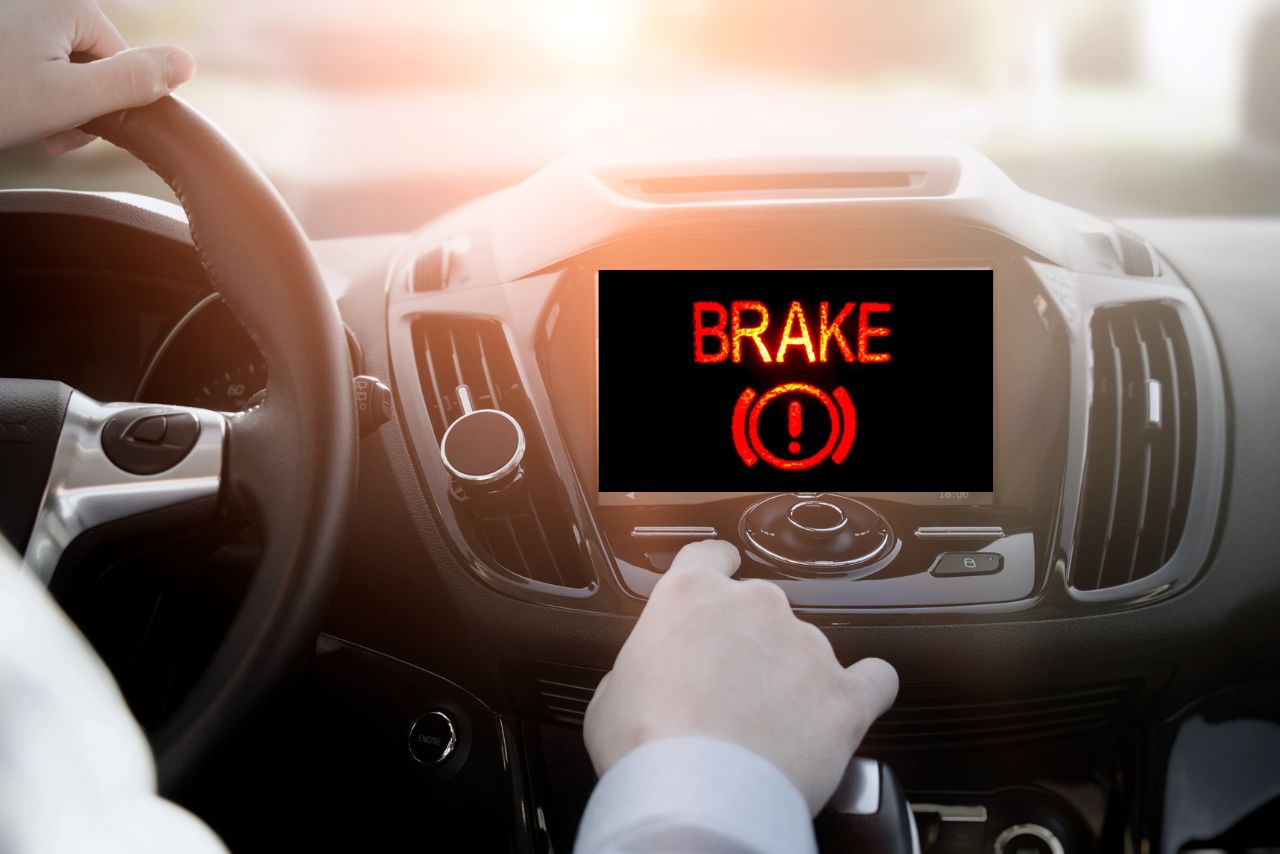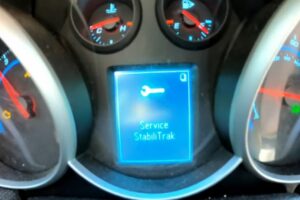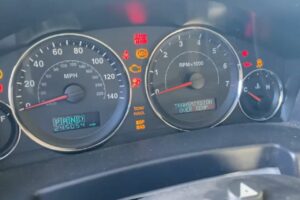Are you seeing a Audi Brake Light on Dash? It can be concerning when any dash light comes on unexpectedly, but when it’s related to your car’s braking system, it’s essential to address the issue promptly.
Not only can malfunctioning brakes cause serious and expensive damage to your vehicle, but they also pose risks while driving.
But what does the brake warning light mean? And what should you do if it appears on your dashboard?
In this article, we will explore common causes for a brake warning light in an Audi A6 C6 and discuss symptoms of brake issues that may require attention from an expert mechanic.
Common causes for a brake warning light include faulty brake pads, boosters, worn-out brake linings, low brake fluid, and master cylinder issues. Checking the brake fluid level and looking for fluid leaks can help diagnose some brake issues. Repairing brake issues is crucial for the safety of drivers and others on the road.
Symptoms of brake issues include spongy brake pedal pulsation, steering wheel vibrations when braking, lengthy stopping distances, or other stop-related symptoms.
Table of contents
What Does a Brake Warning Light Mean?
If you are driving an Audi and see a brake warning light on your dashboard, it typically means that there is something wrong with the braking system of your vehicle.
This warning light shouldn’t be ignored, as faulty brakes can put both the driver and other road users in danger. It’s important to address this issue as soon as possible to prevent costly damage to your car.
Some potential causes for the brake light on the dashboard include low brake fluid level, worn-out brake pads, faulty brake pedal switch or sensor malfunction, vacuum pump issues, or problems with the master cylinder.
Verifying that this warning light is working properly during vehicle start-up is essential for ensuring safety while driving.
Common Reasons for a Brake Warning Light on Audi Dash:
If you see a brake warning light on the dashboard of your Audi, it’s important to address the issue promptly to prevent serious and expensive damage to your vehicle.
| Brake Light | Possible Cause |
|---|---|
| Brake system alert light | Low brake fluid level, brake fluid leak, brake pad wear, or a problem with the brake booster. |
| ABS warning light | Problem with the anti-lock braking system (ABS). |
| Electronic parking brake warning light | Problem with the electronic parking brake. |
| Brake pad wear indicator | Brake pads are worn and need to be replaced. |
1. Low Brake Fluid Level:
Low brake fluid level is one of the most common reasons for a brake warning light on an Audi dashboard.
It’s important to check the brake fluid regularly and top it up when necessary. If you notice that the fluid level is consistently low, there may be a leak in your braking system, which can lead to serious problems if left unaddressed.
If you see a brake warning light on your Audi dashboard, don’t ignore it.
Take your vehicle to a qualified mechanic as soon as possible to ensure proper diagnosis and repair of any issues with your braking system.
Remember that malfunctioning brakes can put both you and other drivers at risk, so it’s always better to be safe than sorry.
2. Worn Out Brake Pads:
Another common cause of a brake warning light on the dashboard of your Audi is worn-out brake pads.
Brake pads are designed to wear down over time and eventually need to be replaced. If they are not replaced in time, they can cause damage to other parts of your braking system, which can become expensive to fix.
If you notice any symptoms related to worn-out brake pads, such as squeaking or grinding noise when applying brakes, reduced braking power or longer stopping distances, it’s important to get them checked out by a mechanic immediately.
3. Faulty Brake Pedal Switch:
Another potential cause of a brake warning light on the Audi dashboard is a faulty brake pedal switch.
This switch is located on the brake pedal and is responsible for sending a signal to the vehicle’s computer system when the brakes are engaged.
If this switch is faulty, it may not send an accurate signal to the computer system, which can trigger the brake warning light to turn on.
In some cases, the brakes may still work properly even with a faulty brake pedal switch, but it’s important to get this issue addressed promptly.
To check if this might be causing your issue, start by pressing lightly on your brakes while parked and see if any lights come up. If not accessible from there, you might need to inspect or replace the switch itself.
4. Brake Sensor Malfunction:
Another common cause for a brake warning light on an Audi dashboard is a malfunctioning brake sensor.
This sensor is responsible for detecting the wear of the braking system and alerting the driver when new pads need to be installed.
If this sensor malfunctions, it can trigger the brake warning light to turn on even if there is no issue with the brakes themselves. In some cases, it might require a replacement of this sensor to fix the problem.
To troubleshoot whether or not it’s due to a malfunctioning sensing mechanism, you could check if there are any obvious signs of wear-and-tear causing issues such as grinding noises when braking or excessive vibration while driving at high speeds etc.
5. Vacuum Brake Booster Pump Issues:
One potential cause of a brake warning light on your Audi dashboard could be issues with the vacuum brake booster pump.
This component is responsible for providing extra power to the brakes, making it easier to apply them and reducing braking distance.
If there’s a problem with the vacuum brake booster pump, you might notice that your brakes feel spongy or require more effort to engage. You may also hear hissing sounds coming from under the hood while pressing the pedal.
To diagnose this issue, you can start by inspecting the vacuum hoses and checking for any leaks or cracks. If they are in good shape, then it may be time to replace the vacuum brake booster pump itself.
How to Inspect and Fix the Audi Brake Light on Dash?
If you notice the brake warning light on your Audi dashboard, it’s crucial to inspect and fix the issue promptly for safety reasons. Here are some steps that could help diagnose and repair the issue:

Step 1: Check the Brake Fluid Level:
The first step to identifying the reason for the brake warning light on your Audi’s dashboard is to check the brake fluid level.
Low brake fluid levels can trigger the warning light and indicate that there might be a leak in the system, which needs to be addressed promptly.
To check your brake fluid level, locate the brake fluid reservoir under your vehicle’s hood.
The location of this may vary depending on the model of your vehicle. Once you have located it, make sure that it is accessible and clean any debris from around it.
Ensure that your vehicle’s engine is turned off before removing the cap of the reservoir and checking if its contents are between indicated minimum (MIN) and maximum (MAX) points.
If they’re low or below MIN line add recommended type of DOT four or higher quality fluid precisely up to MAX mark only as overfilling could cause other issues in turn.
Remember, low brake fluid can lead to problems with braking power which could be extremely hazardous while driving, so always take a look at this issue right away!
Step 2: Inspect the Brake Pads and Sensors:
After checking the brake fluid level, it’s time to inspect the brake pads and sensors. The warning light on your Audi’s dashboard could be a result of worn-out brake pads or faulty sensors.
If you have accessible wheels, you can potentially inspect the pads yourself by looking through the spokes of the wheel.
Check both sides of each tire for uneven wear or if the pad thickness is below 3mm. If one side is more worn than the other, this could indicate a problem with that particular caliper or rotor.
Alternatively, bring your vehicle to a qualified mechanic who can take care of this inspection for you. They have tools and expertise necessary to perform an in-depth inspection and diagnose any underlying issues causing your brake warning light.
If you do need new brake pads, consider getting high-quality replacements from Autozone with lifetime warranties for front and back pads as well as two-year warranty on all four rotors.
Also note that replacing only front brakes may cause rear brakes to wear faster due to imbalance in braking performance. Therefore, it’s ideal to replace both sets simultaneously.
Don’t ignore any potential problems with your car’s brakes – they’re a crucial component for driving safety!
Step 3: Check the Brake Pedal Switch:
The brake pedal switch is an important component of the braking system that can cause the brake warning light to illuminate if it becomes faulty.
When you press down on the brake pedal, the switch sends a signal to your vehicle’s computer system, which then activates your brake lights and may also activate other safety features.
If you suspect that the brake pedal switch is causing your brake warning light to come on, there are a few things you can do to check it:
- First, make sure that the parking brake is disengaged and that your foot isn’t accidentally pressing down on both pedals at once.
- Locate the switch under or near the pedal and inspect it for any damage or signs of wear.
- Try manually activating the switch by pushing or pulling it with your hand while pressing down on the brakes; if this causes your brake lights to turn on, then there may be a problem with how well-connected it is.
- Finally, try repositioning or tightening any loose connections or screws before replacing this part entirely.
Checking and fixing issues with components like a malfunctioning brake pedal switch should be done promptly for optimal driving safety.
So don’t hesitate to consult with a qualified mechanic who has experience working with vehicles like yours in case you need additional help troubleshooting potential problems!
Step 4: Vacuum Brake Booster Pump Inspection:
The vacuum brake booster pump is an essential component of the braking system in Audi vehicles.
If the vacuum brake booster pump malfunctions, you might notice that you have to press harder on the brake pedal or that the brakes don’t engage as quickly as they should.
To inspect the vacuum brake booster pump, start by checking for any visible signs of damage or wear.
Look for cracks or leaks in hoses and check that all connections are secure. Then, test the function of the pump by turning on your engine and listening for any abnormal noises from under your hood.
If there are no visible issues, but you still suspect a problem with your vacuum brake booster pump, take your car to a qualified mechanic who can use diagnostic tools to figure out what’s causing this malfunction.
It could be a potential safety issue and needs proper attention before it causes further damage to other parts of your vehicle.
Step 5: Get Your Car Scanned:
Sometimes there could be issues that aren’t immediately accessible or visible. Taking your vehicle to a certified mechanic to have it scanned will give you an accurate diagnosis.
Once you’ve identified the cause of this problem, take appropriate action like replacing any worn-out parts such as brake pads or boosters.
In general, address problems related to brakes as soon as possible because driving with faulty brakes can cause damage to other parts of your vehicle and potentially result in accidents.
How to Fix the Issue?

Brake Pad Replacement:
Brake pads are a crucial component of the braking system, responsible for slowing down and stopping your Audi.
If you suspect that worn-out brake pads might be causing the brake warning light to appear on your dashboard, replacing them is necessary.
To replace the front and rear brake pads on an Audi A6 C6, you’ll need some basic tools such as a lug wrench, socket set, and brake caliper tool.
It’s also important to choose high-quality replacement parts from reputable brands like Autozone or ECS to ensure safety and longevity.
When replacing the brake pads, it’s recommended to change both the front and rear pads at once if possible as uneven wear can cause handling issues.
The cost of replacing all four sets of brakes will vary depending on the make and model of your vehicle but ranges from $100-$300 per axle.
Brake Fluid Exchange:
Another potential fix for a brake warning light on your Audi dashboard is a brake fluid exchange.
Over time, brake fluid can become contaminated with moisture and debris, which can reduce its effectiveness and lead to issues with the braking system.
To exchange the brake fluid, start by locating the master cylinder reservoir and removing as much of the old fluid as possible using a turkey baster or similar tool.
Then, add new brake fluid to the reservoir and bleed the brakes to remove any air bubbles in the system.
It’s important to use only brake fluids that meet Audi’s specifications and to follow proper safety procedures when working with this potentially hazardous substance.
If you’re not comfortable performing this task yourself, have it done by a qualified mechanic.
Rotor Replacement:
If your brake warning light is on, there’s a potential that the issue could be related to worn-out rotors.
The rotor is an important component of the braking system, and it works in conjunction with the pads to slow down the vehicle.
Over time and use, rotors can become warped or damaged, leading to uneven wear of the brake pads and ultimately causing a need for replacement.
Symptoms that your rotors may need replacing include pulsation or vibration when applying brakes or lengthy stopping distances.
Replacing brake rotors can sometimes be done by yourself if you’re comfortable working on cars and have accessible tools.
When getting new brake rotors installed, make sure they are high-quality and meet manufacturer specifications for your Audi model. It’s also recommended that you replace both front and rear sets at once for optimum braking performance.
Brake Master Cylinder Replacement:
If none of the previous fixes have worked and you are still experiencing issues with your brake warning light, it might be time to consider a brake master cylinder replacement.
The brake master cylinder is what creates hydraulic pressure that moves the fluid through the braking system.
Replacing this part may involve bleeding the brakes, which means removing all air from the system so that it works properly. This can be a complex job and is best done by a qualified mechanic.
Symptoms of a faulty brake master cylinder include: spongy or soft brake pedal, unusual noises when braking, or leaking brake fluid.
If you notice any of these symptoms in addition to your brake warning light being on, it’s important to get your vehicle checked out by a professional as soon as possible.
Ignoring these issues can potentially cause damage to other components in your vehicle and compromise safety while driving.
So make sure you take care of any potential problems related to your brakes promptly for peace of mind on the road.
Brake Booster Replacement:
If you have checked the brake fluid level and inspected the brake pads, but the warning light on your Audi dashboard still won’t go off, it’s possible that the issue might be with the brake booster.
The brake booster is a component of your vehicle’s braking system that uses vacuum pressure to assist in applying force to the brakes.
If this component is not working properly, it can cause issues with the power or feel of your brakes.
Some potential symptoms of a faulty brake booster include increased pedal effort needed to engage your brakes or a spongy feeling when pressing down on the pedal.
Conclusion and final thoughts 💭
If the brake warning light on your Audi’s dashboard is illuminated, it’s essential to take prompt action.
Ignoring the issue or continuing to drive with a malfunctioning braking system can potentially cause serious damage to your vehicle and lead to safety concerns for you and other drivers on the road.
It’s important to check the brake fluid level, inspect the brake pads and sensors, examine the brake pedal switch, and perform a vacuum brake booster pump inspection.
If none of these steps work in resolving the issue, it’s advisable to get your car scanned by a qualified mechanic who can identify any underlying problems.
Once you’ve identified the cause of the problem, there are several potential fixes available.
Depending on whether it’s due to faulty brake pads or boosters or worn-out linings or low fluid levels- different parts might need replacement like rotors may need replacement too- repairs such as replacing or exchanging brakes master cylinder which causes no hydraulic power will fix this wrong doing immediately.
Latest Posts:
- Can WD-40 Remove Scratches on Cars? (Hint: Yes, but…)
- Can You Use a Drill to Polish Your Car? (We Tried it Out!)
- Should You Cover Car Scratches With Stickers? (REVEALED!)
- Buick Service Stabilitrak: (Causes & 100% Guaranteed Fix!)
- Common Holden Trax Problems (Causes & 100% Proven Fixes!)
- Jeep Commander Transmission Over Temp: (Guaranteed Fix!)












Leave a Reply